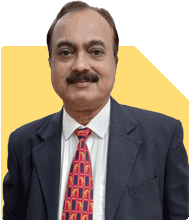Can I afford to retire in March 2025 with Rs 1.8 crores in savings?
Ramalingam Kalirajan |7059 Answers |Ask -Follow
Mutual Funds, Financial Planning Expert - Answered on Nov 19, 2024
He has an MBA in finance from the University of Madras and is a certified financial planner.
He is the director and chief financial planner at Holistic Investment, a Chennai-based firm that offers financial planning and wealth management advice.... more

I own few flats that generate a monthly rental income of Rs95,000. Additionally, I have a few residential land properties and no outstanding loans. Including all my savings, I have approximately Rs1.8 crores. I am into IT field working in an MNC My current monthly take-home salary is Rs2.9 lakhs. I have a daughter who is currently pursuing her B.Tech. I plan to take a six-month break in March 2025, and after that, if I don't secure another job, can I afford to retire?
Your rental income of Rs 95,000 is consistent and predictable.
Owning land and flats provides financial security and growth potential.
A monthly salary of Rs 2.9 lakhs places you in a strong earning bracket.
Savings of Rs 1.8 crores give you flexibility and liquidity.
With no loans, your financial commitments are minimal.
Supporting your daughter in her B.Tech is admirable.
Your situation is ideal for evaluating early retirement.
Key Factors to Evaluate Retirement Readiness
1. Monthly Living Expenses
Analyse your current lifestyle expenses, including rent, food, utilities, and travel.
Account for increased expenses during your six-month break.
Ensure your rental income can cover your basic needs post-retirement.
Plan for additional expenses like hobbies, healthcare, and travel.
2. Daughter’s Higher Education Costs
Calculate the remaining costs for her education and any future needs.
Ensure funds are available for her marriage or further studies.
Avoid liquidating long-term assets for these short-term needs.
3. Health and Emergency Planning
Medical costs rise with age. Invest in a comprehensive health insurance plan.
Set aside an emergency fund equal to 12 months of expenses.
Consider critical illness cover for additional health-related security.
4. Lifestyle and Goals After Retirement
Define your desired lifestyle. Include travel, leisure, or new ventures.
Account for inflation in your retirement expense planning.
Building a Retirement Corpus
1. Existing Investments
Review current investments for growth and diversification.
Avoid overexposure to a single asset class, like real estate.
2. Mutual Funds for Long-Term Growth
Shift savings into diversified, actively managed equity mutual funds.
Actively managed funds outperform index funds in emerging markets like India.
Regular plans through an MFD with CFP credentials ensure consistent support.
Equity mutual funds offer inflation-beating returns over the long term.
3. Debt Funds for Stability
Allocate part of your portfolio to debt mutual funds.
Debt funds balance risks and offer steady returns.
They provide easy liquidity during market volatility.
4. Dividend-Based Strategies
Consider high-quality mutual funds with dividend payout options.
Dividend income can supplement your rental earnings.
Maximising Rental Income
Review current rental agreements for scope to increase rents.
Focus on high-demand areas to maximise returns on vacant properties.
Regular maintenance enhances property value and rent potential.
Avoid over-reliance on rental income alone for retirement.
Tax Optimisation
1. Rental Income
Rental income is taxed under "Income from House Property."
Use deductions like municipal taxes and 30% standard deduction.
2. Mutual Fund Returns
For equity mutual funds, LTCG above Rs 1.25 lakhs is taxed at 12.5%.
STCG from equity mutual funds attracts a 20% tax rate.
Debt funds’ LTCG and STCG are taxed as per your income tax slab.
Plan redemptions carefully to minimise tax liability.
Contingency for Post-Break Scenario
Use the six-month break to assess alternative income streams.
Evaluate freelance or consulting opportunities in IT.
Start passive income ventures like online courses or content creation.
Additional Recommendations
Track inflation and adjust your plans accordingly.
Avoid new real estate investments as they are illiquid and non-diversified.
Reinvest rental income surplus into mutual funds for compounding growth.
Regularly review your portfolio with your Certified Financial Planner.
Finally
You are financially secure and prepared to take a career break.
However, ensure your retirement corpus matches your desired lifestyle.
With proper planning, early retirement is achievable and sustainable.
Focus on a balanced portfolio and keep future goals in mind.
Best Regards,
K. Ramalingam, MBA, CFP,
Chief Financial Planner,
www.holisticinvestment.in
https://www.youtube.com/@HolisticInvestment
You may like to see similar questions and answers below
Ramalingam Kalirajan |7059 Answers |Ask -Follow
Mutual Funds, Financial Planning Expert - Answered on May 13, 2024
Ramalingam Kalirajan |7059 Answers |Ask -Follow
Mutual Funds, Financial Planning Expert - Answered on Jul 04, 2024
Ramalingam Kalirajan |7059 Answers |Ask -Follow
Mutual Funds, Financial Planning Expert - Answered on Aug 23, 2024
Ramalingam Kalirajan |7059 Answers |Ask -Follow
Mutual Funds, Financial Planning Expert - Answered on Nov 02, 2024
Ramalingam Kalirajan |7059 Answers |Ask -Follow
Mutual Funds, Financial Planning Expert - Answered on Nov 05, 2024
Ramalingam Kalirajan |7059 Answers |Ask -Follow
Mutual Funds, Financial Planning Expert - Answered on Nov 19, 2024
Pradeep Pramanik |178 Answers |Ask -Follow
Career And Placement Consultant - Answered on Nov 19, 2024
Pradeep Pramanik |178 Answers |Ask -Follow
Career And Placement Consultant - Answered on Nov 19, 2024
Ramalingam Kalirajan |7059 Answers |Ask -Follow
Mutual Funds, Financial Planning Expert - Answered on Nov 19, 2024
Prof Suvasish Mukhopadhyay |126 Answers |Ask -Follow
Career Counsellor - Answered on Nov 19, 2024
Prof Suvasish Mukhopadhyay |126 Answers |Ask -Follow
Career Counsellor - Answered on Nov 19, 2024
Prof Suvasish Mukhopadhyay |126 Answers |Ask -Follow
Career Counsellor - Answered on Nov 19, 2024
Ramalingam Kalirajan |7059 Answers |Ask -Follow
Mutual Funds, Financial Planning Expert - Answered on Nov 19, 2024
Ramalingam Kalirajan |7059 Answers |Ask -Follow
Mutual Funds, Financial Planning Expert - Answered on Nov 19, 2024



















